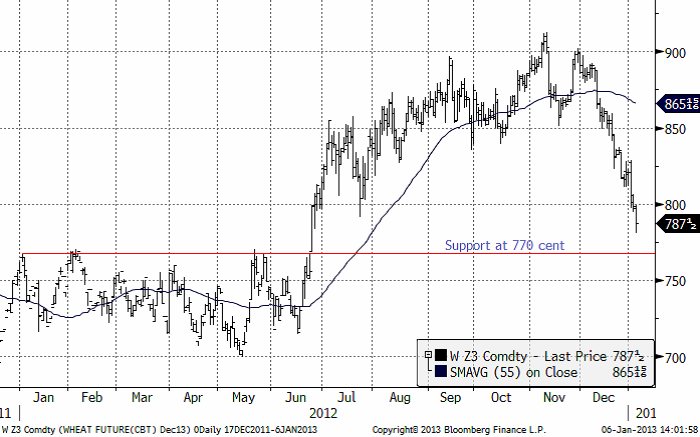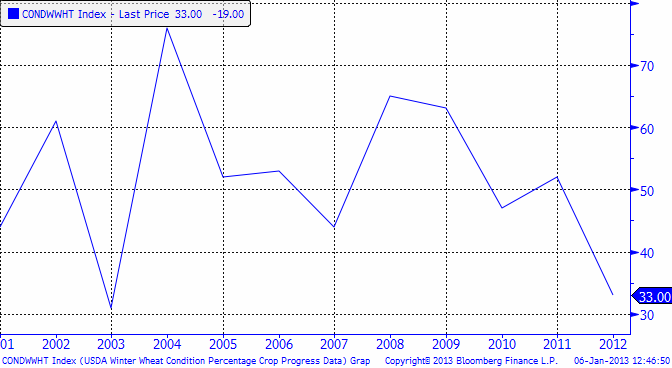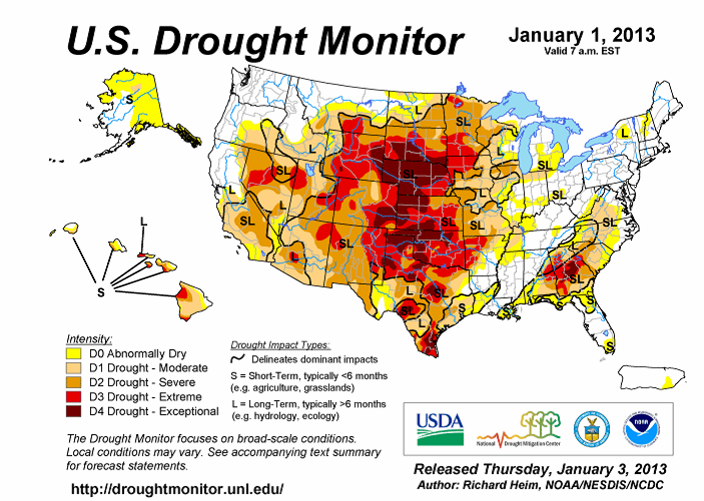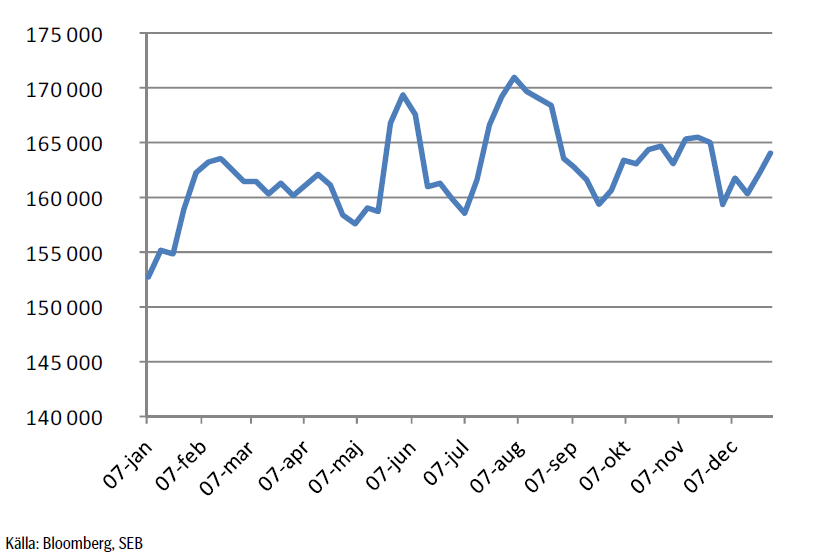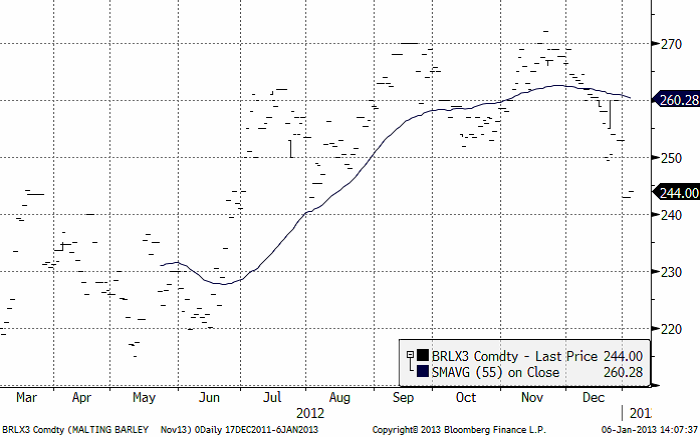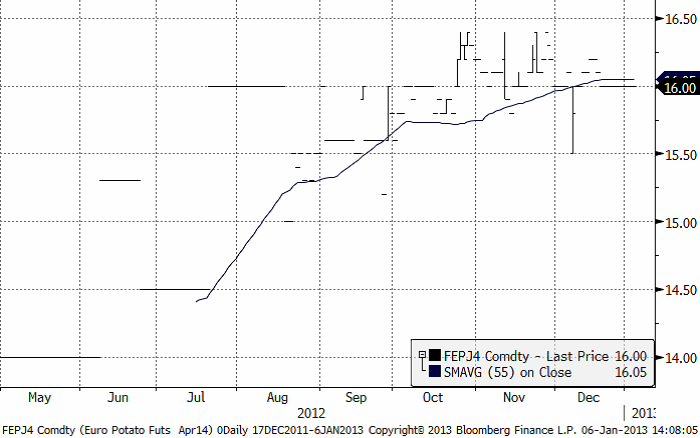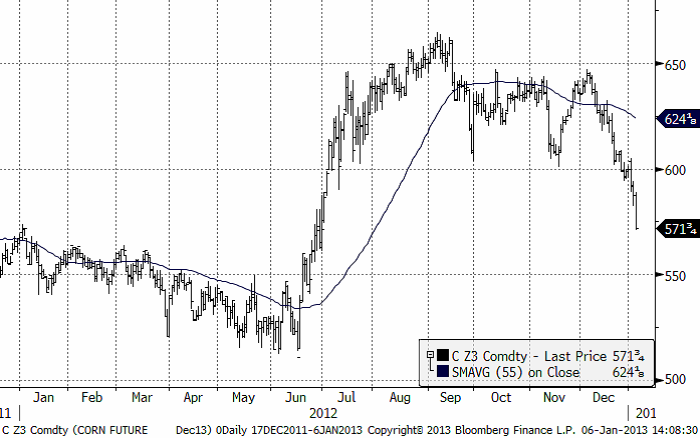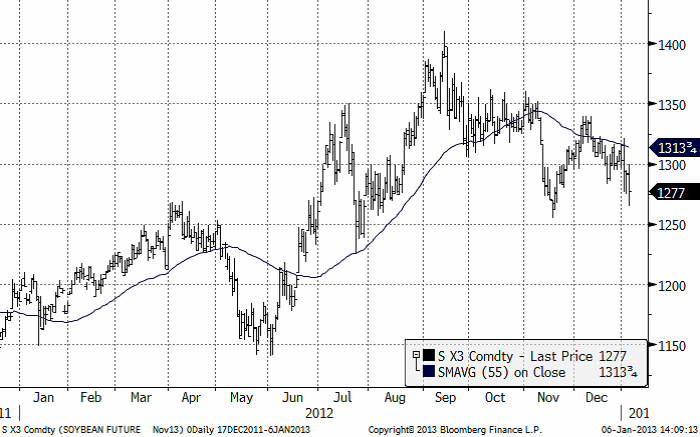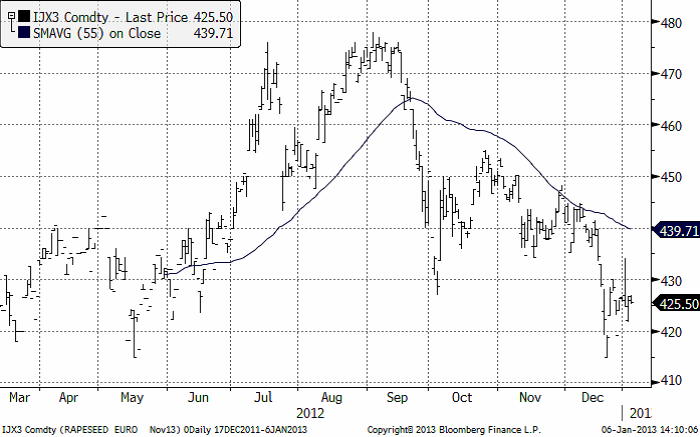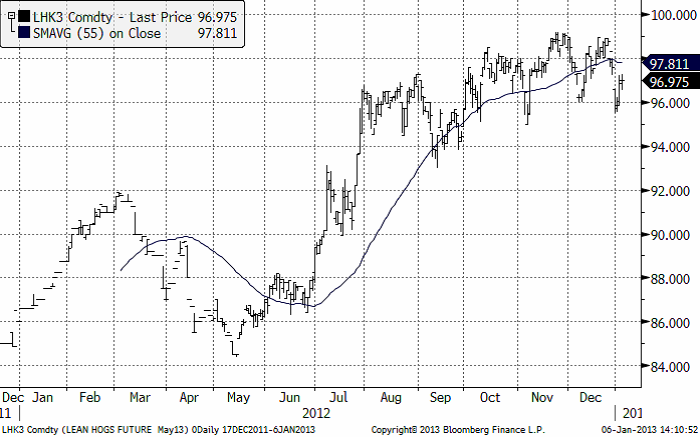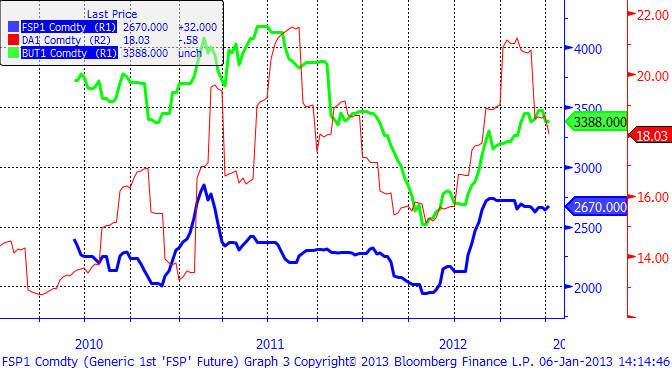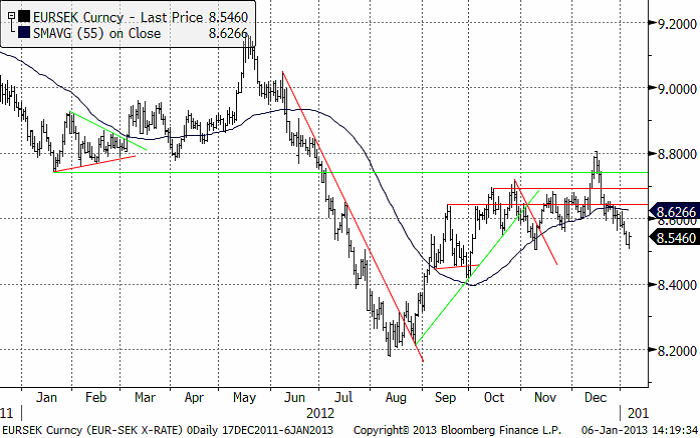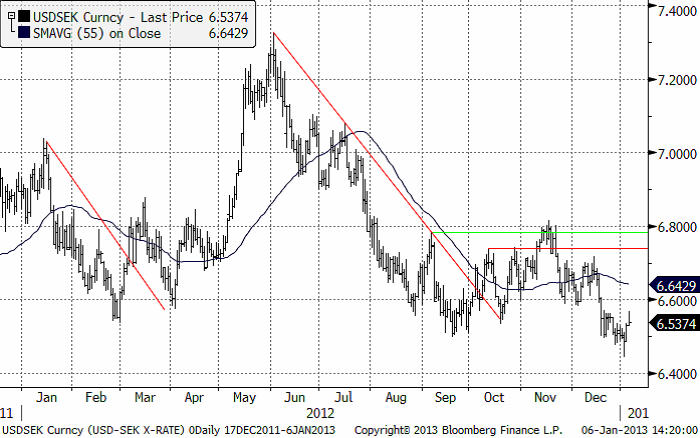Analys
SEB Jordbruksprodukter, 7 januari 2013
 I det senaste veckobrevet som publicerades i mitten av december, hade vi gått över till säljrekommendation på alla jordbruksprodukter. Priserna på i synnerhet vete och majs har fallit kraftigt sedan dess. Ser man till väderläget i USA och crop condition för höstvetet ser man dock inte några motiv till stora prisfall på majs och vete. Läget väger mellan extrema utfall – antingen ännu lägre pris eller högre pris om det blir ytterligare ett år med missväxt samtidigt som global efterfrågan tar ny fart.
I det senaste veckobrevet som publicerades i mitten av december, hade vi gått över till säljrekommendation på alla jordbruksprodukter. Priserna på i synnerhet vete och majs har fallit kraftigt sedan dess. Ser man till väderläget i USA och crop condition för höstvetet ser man dock inte några motiv till stora prisfall på majs och vete. Läget väger mellan extrema utfall – antingen ännu lägre pris eller högre pris om det blir ytterligare ett år med missväxt samtidigt som global efterfrågan tar ny fart.
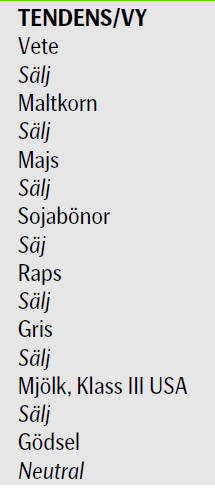 Eftersom vi huvudsakligen sysslar med terminer på jordbruksprodukter här på SEB, kan det vara av intresse att summera året inte bara i hur mycket spotpriserna rörde sig under året som gått, utan också hur mycket avkastning en position via terminer hade gett.
Eftersom vi huvudsakligen sysslar med terminer på jordbruksprodukter här på SEB, kan det vara av intresse att summera året inte bara i hur mycket spotpriserna rörde sig under året som gått, utan också hur mycket avkastning en position via terminer hade gett.
Så här summerar vi kortfattat förra året
Sojabönor: Spotprisförändring: +11%. Terminsavkastning (om köpt): +18%
Majs: Spotprisförändring +3%. Terminsavkastning (om köpt): +14%
Chicagovete: Spotprisförändring +15%. Terminsavkastning (om köpt): +6%
US Lean Hogs: Spotprisförändring +1%. Terminsavkastning (om köpt): -3%
Socker: Spotprisförändring -23%. Terminsavkastning (om köpt): -20%
Notera att man ”som vanligt” tjänat på att sälja Chicagovetet i förhållande till spotpriset. Ska man prissäkra vete, är det nästan alltid lönsammast att göra det i en valutasäkrad Chicagotermin istället för en valutasäkrad Matif-termin.
På fredag är det dags för årets första WASDE-rapport. Då publicerar också USDA den viktiga lagerstatistiken per den första december 2012.
Vete
Hur kommer vetepriset att utveckla sig fram till hösten i år? Rätt svar på den frågan är värt hundratusentals kronor för en genomsnittlig spannmålsodlare. Läget är genuint osäkert och väger mellan extrema möjligheter, eller hot, om man så vill. Situationen på marknaden mäts i siffror. Vi ska här gå igenom
- Crop condition
- Spekulanternas position i marknaden (som återspeglar vad den kategorin tror om framtida prisutveckling)
- Torkan i USA
Vi ska också titta lite på säsongsmönstret i lantbrukares försäljning av terminer och konsumtion.
Men först en genomgång av prisutvecklingen.
Nedan ser vi november (2013) kontraktet, där priset ligger på 220 euro, en viss stödnivå.
Nedan ser vi decemberkontraktet på CBOT. Vi ser att priset fallit tämligen kraftigt sedan mitten av december. Vår säljrekommendation på vete har här alltså fungerat väl för dem som följde rådet. Vi ser också att prisfallet nu bör börja närma sig sitt slut. Det finns ett ganska starkt stöd på 770 cent. Strax under den nivån har det skett mycket handel tidigare och kursfallet kommer antagligen att bromsas upp på den nivån.
Nedan ser vi kursdiagrammet för kommande skörd, november 2013. Priset bröt den uppåtgående stödlinjen vid strax över 240 euro per ton som en respons på WASDE-rapporten. Därefter har priset fallit ner till stödlinjen vid 235 euro. Där fanns köpare. Det är möjligt att det kommer en rekyl uppåt i veckan. Vi anser att den rekylen uppåt i så fall är ett säljtillfälle, och rekylen bör maximalt, enligt den tekniska analysen, gå upp mot 240 euro, men troligtvis inte över.
Crop Condition
Endast 33% av det övervintrande höstvetet var i ”good” eller ”excellent condition” den sista rapporteringsdagen i december förra året. Nedan ser vi hur läget har varit vid samma tid föregående år.
Som vi ser är vetet startar vetet i sin sämsta form sedan 2003 (som följdes av vår och sommar, skörd och – prisuppgång år 2004).
Torkan i USA håller i sig. Det är den värsta torkan sedan 30-talets ”dust bowl”. Vi ser att torkan är väst precis där vetedistrikten ligger.
Spekulanterna har tagit fasta på att ”höga priser” stimulerar mer produktion och sålt terminer kraftigt. Den röda linjen i diagrammet nedan visar nettopositionen för kategorin terminshandlare som klassificeras om ”non-commercials” i CFTC:s sammanställning. Den blå kurvan är priset på spotkontraktet på CBOT.
Eftersom det ser ut som ”alla” har sålt så kanske en del tycker att det då inte kan finnas någon kvar att sälja. Men ”commercials”, dvs bönder har ännu inte påbörjat sin prissäkringssäsong. Den brukar börja när snön försvinner och man får ett bättre grepp om hur mycket, om något, som finns att prissäkra.
Nedan ser vi genomsnittet under året av ”Commercial Net Short Futures Position” enligt CFTC:s data.
Genomsnitts-positionen är beräknad med veckovis data från och med 2003 till och med 2012. Som ”commercial” klassificeras t ex lantbrukare, kvarnar och spannmålshandlare (lagerhållare). Toppen vi ser i juli-augusti, beror troligen på att spannmålshandlarna / lagerhållarna säljer terminer för att prissäkra den inköpta varans värde. Vi ser att antalet sålda kontrakt säsongsmässigt ökar kraftigt i början av året, när lantbrukarna för allt mer klart för sig hur mycket det finns att prissäkra.
De strategier som redovisas i boken ”Bättre betalt för skörden” av Iwarson, 2012, visar att februari har varit den bästa månaden att prissäkra sedan (åtminstone) 1980. Priset på december-terminen på Chicago Board of Trade har i genomsnitt haft sin högsta premie då och gett högst vinst på prissäkringen.
Sammanfattningsvis: I början av december, i det senaste veckobrevet, bytte vi från köprekommendation till säljrekommendation. Prisfallet har nu varit så stort att priset kommer ner mot naturliga stödnivåer.
Samtidigt hopar sig hoten inför våren och sommaren i form av exceptionellt dålig form på höstvetet i USA och ihållande torka och redan mycket låga lager av gammal skörd. Vi förbereder oss därför på att gå över till i första hand en neutral rekommendation, eventuellt om en vecka.
Maltkorn
November 2013-kontraktet har fortsatt att falla i pris för andra veckan. Vi ser i diagrammet nedan att styrkan i marknaden successivt har avtagit sedan slutet av sommaren.
Potatis
Potatispriset för leverans i april har sjunkit något sedan förra veckan och handlas nu under 30 euro per dt. Även i potatismarknaden ser vi att styrkan i uppgången har avtagit de senaste månaderna.
Majs
Majspriset (mars 2013) har fallit tämligen kraftigt. Euforin över att ”Fiscal cliff” undveks vid årsskiftet blev kortvarig. Produktionen av etanol i USA nådde för första året på länge inte en ny rekordnivå i USA.
Ökningstakten i efterfrågan på etanol har alltså vänts till en minskning. Den här efterfrågepressen uppåt på priset tycks nu av allt att döma vara borta.
Marknaden har tagit fasta på att det höga priset ”borde” stimulera i ökad areal och därmed ökad produktion. Men som vi sett ovan finns det ett stort underskott av markfukt i USA. Det borde ha regnat mer än normalt de senaste månaderna och det måste regna mer än normalt ända fram till maj för att normalisera markfukten. Det har som bekant inte alls regnat så mycket och prognosen framöver visar inga tecken på att det ska göra det. Sådden kommer alltså att ske under torra förhållanden.
Tekniskt stöd finns på 550 cent i decemberkontraktet, som vi ser i diagrammet nedan. Det mesta av prisfallet är alltså troligtvis bakom oss.
Sådden i Argentina är till 80% avklarad enligt BAGE. Sådden kommer snart att vara helt avklarad. På fredag publicerar USDA den viktiga lagerstatistiken per den 1 december i USA. Viktigast av den lagerstatistik som publiceras kommer att bli den för majs.
Sojabönor
Till skillnad från spannmålen majs och vete har sojabönorna fallit endast lite sedan december. Sojamjölet föll 7% förra veckan, medan sojaoljan gick upp med 2%. Farm Bill från 2008 förlängdes eftersom den som blandar i biodiesel i dieselbränslet får behålla en dollar i skatterabatt per gallon. Det var inte många som räknat med det.
Fokus lämnar nu allt mer den nordamerikanska marknaden och flyttar till den sydamerikanska. Argentinska BAGE (Buenos Aires Grain Exchange) rapporterade förra veckan att sådden i landet var klar till 85%.
Varmare och torrare väder har återkommit till Argentina. Nederbörden i Brasilien har ökat, vilket är gynnsamt. Däremot lider nordöstra Brasilien av den värsta torkan på 50 år, rapporterar media. Vi förstår inte riktigt detta, när våra kontakter på platsen säger att det regnar ordentligt i Natal. I Rio de Janeiro är det översvämningar överallt och det var 45 grader på nyårsafton. Vi tror att oron för väderproblem i Sydamerika är överdriven.
Raps
Rapspriset (november 2013) har en teknisk stödnivå strax under dagens kursnivå. Priset ligger strax över förra årets bottennoteringar. Det rapporteras från Indien att förnyad torka i landet sätter rapsskörden i farozonen.
Gris
Grispriset (Maj 13), amerikansk Lean Hogs, har haft en fin prisuppgång sedan i somras. Trenden har dock förlorat nästan all sin kraft. De senaste tre månaderna har priset egentligen rört sig ”sidledes”, vilket kan vara slutet på uppgångsfasen. Fallande pris på majs och sojamjöl bör, allt annat lika, leda till högre grisproduktion och därmed lägre priser.
Mjölk
I diagrammet nedan ser vi tre kurvor. Den tunna röda är priset på klass 3-mjölk i cent per pund på CMEbörsen.
Vi ser att priset sedan mitten av december fallit från 21 cent till 18.03 cent. Den gröna linjen är priset på smör på Eurex börsen. Priset anges i euro per ton, 3388 euro per ton. Den blåa linjen är priset på skummjölkspulver i euro per ton på Eurex-börsen. Priserna på smör och SMP har legat stabilt den senaste månaden.
Det börsbaserade priset i svenska kronor beräknas med formeln:
där
BUT = priset på smör i euro per ton
SMP = priset på skummjölkspulver i euro per ton
FX = växelkursen för EURSEK.
EURSEK
EURSEK har de senaste veckorna återigen försvagats mot kronan. Det finns inte mycket som tyder på att en förstärkning i euron skulle vara förestående, men inte heller några starka tecken på kursfall.
USDSEK
Dollar stärktes något märkligt av den halvmesyr som undvikandet av ”Fiscal Cliff” innebar. Den politiska uppgörelsen i USA innebär endast att beslutet skjuts upp två månader. Med tiden kommer Fiscal Cliff återigen galopperande. Ironiskt nog innebär uppgörelsen att de federala utgifterna höjdes. Inte sänktes.
[box]SEB Veckobrev Jordbruksprodukter är producerat av SEB Merchant Banking och publiceras i samarbete och med tillstånd på Råvarumarknaden.se[/box]
Disclaimer
The information in this document has been compiled by SEB Merchant Banking, a division within Skandinaviska Enskilda Banken AB (publ) (“SEB”).
Opinions contained in this report represent the bank’s present opinion only and are subject to change without notice. All information contained in this report has been compiled in good faith from sources believed to be reliable. However, no representation or warranty, expressed or implied, is made with respect to the completeness or accuracy of its contents and the information is not to be relied upon as authoritative. Anyone considering taking actions based upon the content of this document is urged to base his or her investment decisions upon such investigations as he or she deems necessary. This document is being provided as information only, and no specific actions are being solicited as a result of it; to the extent permitted by law, no liability whatsoever is accepted for any direct or consequential loss arising from use of this document or its contents.
About SEB
SEB is a public company incorporated in Stockholm, Sweden, with limited liability. It is a participant at major Nordic and other European Regulated Markets and Multilateral Trading Facilities (as well as some non-European equivalent markets) for trading in financial instruments, such as markets operated by NASDAQ OMX, NYSE Euronext, London Stock Exchange, Deutsche Börse, Swiss Exchanges, Turquoise and Chi-X. SEB is authorized and regulated by Finansinspektionen in Sweden; it is authorized and subject to limited regulation by the Financial Services Authority for the conduct of designated investment business in the UK, and is subject to the provisions of relevant regulators in all other jurisdictions where SEB conducts operations. SEB Merchant Banking. All rights reserved.
Analys
Tightening fundamentals – bullish inventories from DOE

The latest weekly report from the US DOE showed a substantial drawdown across key petroleum categories, adding more upside potential to the fundamental picture.

Commercial crude inventories (excl. SPR) fell by 5.8 million barrels, bringing total inventories down to 415.1 million barrels. Now sitting 11% below the five-year seasonal norm and placed in the lowest 2015-2022 range (see picture below).
Product inventories also tightened further last week. Gasoline inventories declined by 2.1 million barrels, with reductions seen in both finished gasoline and blending components. Current gasoline levels are about 3% below the five-year average for this time of year.
Among products, the most notable move came in diesel, where inventories dropped by almost 4.1 million barrels, deepening the deficit to around 20% below seasonal norms – continuing to underscore the persistent supply tightness in diesel markets.
The only area of inventory growth was in propane/propylene, which posted a significant 5.1-million-barrel build and now stands 9% above the five-year average.
Total commercial petroleum inventories (crude plus refined products) declined by 4.2 million barrels on the week, reinforcing the overall tightening of US crude and products.


Analys
Bombs to ”ceasefire” in hours – Brent below $70

A classic case of “buy the rumor, sell the news” played out in oil markets, as Brent crude has dropped sharply – down nearly USD 10 per barrel since yesterday evening – following Iran’s retaliatory strike on a U.S. air base in Qatar. The immediate reaction was: “That was it?” The strike followed a carefully calibrated, non-escalatory playbook, avoiding direct threats to energy infrastructure or disruption of shipping through the Strait of Hormuz – thus calming worst-case fears.

After Monday morning’s sharp spike to USD 81.4 per barrel, triggered by the U.S. bombing of Iranian nuclear facilities, oil prices drifted sideways in anticipation of a potential Iranian response. That response came with advance warning and caused limited physical damage. Early this morning, both the U.S. President and Iranian state media announced a ceasefire, effectively placing a lid on the immediate conflict risk – at least for now.
As a result, Brent crude has now fallen by a total of USD 12 from Monday’s peak, currently trading around USD 69 per barrel.
Looking beyond geopolitics, the market will now shift its focus to the upcoming OPEC+ meeting in early July. Saudi Arabia’s decision to increase output earlier this year – despite falling prices – has drawn renewed attention considering recent developments. Some suggest this was a response to U.S. pressure to offset potential Iranian supply losses.
However, consensus is that the move was driven more by internal OPEC+ dynamics. After years of curbing production to support prices, Riyadh had grown frustrated with quota-busting by several members (notably Kazakhstan). With Saudi Arabia cutting up to 2 million barrels per day – roughly 2% of global supply – returns were diminishing, and the risk of losing market share was rising. The production increase is widely seen as an effort to reassert leadership and restore discipline within the group.
That said, the FT recently stated that, the Saudis remain wary of past missteps. In 2018, Riyadh ramped up output at Trump’s request ahead of Iran sanctions, only to see prices collapse when the U.S. granted broad waivers – triggering oversupply. Officials have reportedly made it clear they don’t intend to repeat that mistake.
The recent visit by President Trump to Saudi Arabia, which included agreements on AI, defense, and nuclear cooperation, suggests a broader strategic alignment. This has fueled speculation about a quiet “pump-for-politics” deal behind recent production moves.
Looking ahead, oil prices have now retraced the entire rally sparked by the June 13 Israel–Iran escalation. This retreat provides more political and policy space for both the U.S. and Saudi Arabia. Specifically, it makes it easier for Riyadh to scale back its three recent production hikes of 411,000 barrels each, potentially returning to more moderate increases of 137,000 barrels for August and September.
In short: with no major loss of Iranian supply to the market, OPEC+ – led by Saudi Arabia – no longer needs to compensate for a disruption that hasn’t materialized, especially not to please the U.S. at the cost of its own market strategy. As the Saudis themselves have signaled, they are unlikely to repeat previous mistakes.
Conclusion: With Brent now in the high USD 60s, buying oil looks fundamentally justified. The geopolitical premium has deflated, but tensions between Israel and Iran remain unresolved – and the risk of missteps and renewed escalation still lingers. In fact, even this morning, reports have emerged of renewed missile fire despite the declared “truce.” The path forward may be calmer – but it is far from stable.
Analys
A muted price reaction. Market looks relaxed, but it is still on edge waiting for what Iran will do

Brent crossed the 80-line this morning but quickly fell back assigning limited probability for Iran choosing to close the Strait of Hormuz. Brent traded in a range of USD 70.56 – 79.04/b last week as the market fluctuated between ”Iran wants a deal” and ”US is about to attack Iran”. At the end of the week though, Donald Trump managed to convince markets (and probably also Iran) that he would make a decision within two weeks. I.e. no imminent attack. Previously when when he has talked about ”making a decision within two weeks” he has often ended up doing nothing in the end. The oil market relaxed as a result and the week ended at USD 77.01/b which is just USD 6/b above the year to date average of USD 71/b.

Brent jumped to USD 81.4/b this morning, the highest since mid-January, but then quickly fell back to a current price of USD 78.2/b which is only up 1.5% versus the close on Friday. As such the market is pricing a fairly low probability that Iran will actually close the Strait of Hormuz. Probably because it will hurt Iranian oil exports as well as the global oil market.
It was however all smoke and mirrors. Deception. The US attacked Iran on Saturday. The attack involved 125 warplanes, submarines and surface warships and 14 bunker buster bombs were dropped on Iranian nuclear sites including Fordow, Natanz and Isfahan. In response the Iranian Parliament voted in support of closing the Strait of Hormuz where some 17 mb of crude and products is transported to the global market every day plus significant volumes of LNG. This is however merely an advise to the Supreme leader Ayatollah Ali Khamenei and the Supreme National Security Council which sits with the final and actual decision.
No supply of oil is lost yet. It is about the risk of Iran closing the Strait of Hormuz or not. So far not a single drop of oil supply has been lost to the global market. The price at the moment is all about the assessed risk of loss of supply. Will Iran choose to choke of the Strait of Hormuz or not? That is the big question. It would be painful for US consumers, for Donald Trump’s voter base, for the global economy but also for Iran and its population which relies on oil exports and income from selling oil out of that Strait as well. As such it is not a no-brainer choice for Iran to close the Strait for oil exports. And looking at the il price this morning it is clear that the oil market doesn’t assign a very high probability of it happening. It is however probably well within the capability of Iran to close the Strait off with rockets, mines, air-drones and possibly sea-drones. Just look at how Ukraine has been able to control and damage the Russian Black Sea fleet.
What to do about the highly enriched uranium which has gone missing? While the US and Israel can celebrate their destruction of Iranian nuclear facilities they are also scratching their heads over what to do with the lost Iranian nuclear material. Iran had 408 kg of highly enriched uranium (IAEA). Almost weapons grade. Enough for some 10 nuclear warheads. It seems to have been transported out of Fordow before the attack this weekend.
The market is still on edge. USD 80-something/b seems sensible while we wait. The oil market reaction to this weekend’s events is very muted so far. The market is still on edge awaiting what Iran will do. Because Iran will do something. But what and when? An oil price of 80-something seems like a sensible level until something do happen.
-

 Nyheter3 veckor sedan
Nyheter3 veckor sedanStor uppsida i Lappland Guldprospekterings aktie enligt analys
-

 Nyheter4 veckor sedan
Nyheter4 veckor sedanBrookfield ska bygga ett AI-datacenter på hela 750 MW i Strängnäs
-

 Nyheter4 veckor sedan
Nyheter4 veckor sedanSommaren inleds med sol och varierande elpriser
-

 Nyheter4 veckor sedan
Nyheter4 veckor sedanOPEC+ ökar oljeproduktionen trots fallande priser
-

 Nyheter3 veckor sedan
Nyheter3 veckor sedanSilverpriset släpar efter guldets utveckling, har mer uppsida
-

 Analys4 veckor sedan
Analys4 veckor sedanBrent needs to fall to USD 58/b to make cheating unprofitable for Kazakhstan
-

 Nyheter4 veckor sedan
Nyheter4 veckor sedanTradingfirman XTX Markets bygger datacenter i finska Kajana för 1 miljard euro
-

 Nyheter2 veckor sedan
Nyheter2 veckor sedanUppgången i oljepriset planade ut under helgen



